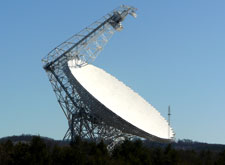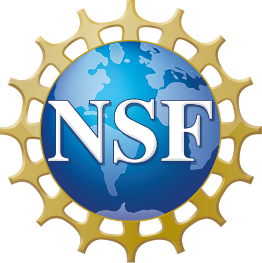GBT 4mm Receiver 2012A Shared-Risk Call for Proposals
The National Radio Astronomy Observatory announces the opportunity for shared-risk proposals for the 2012 August 01 deadline using the new GBT 4mm Receiver. The 4mm system is a traditional dual-beam feed horn receiver designed to cover the low-frequency end of the 3mm atmospheric window from 68-92 GHz (GBT 4mm Receiver). The receiver saw its first light during early test observations in 2011 May ( First Light). The receiver is currently undergoing significant refinements, and the goal is to have the system ready for early commissioning on the GBT in 2011 December. Shared-risk observations for the general community are planned for 2012.
System Performance
- The nominal band for the hardware is 68-92 GHz. Proposals from 66.8 to 93.2 GHz will be accepted, but there is no guarantee of performance outside of the nominal band.
- We expect receiver temperatures of 50-100 K for the middle of the band, with a decrease of performance at ends of the band. We expect system temperatures of 100-200 in good weather (tau<0.1) conditions.
- Observations must be carried out during the night.
- The aperture efficiency for night-time observations is expected to be about 32% at 90 GHz. The performance should be better at lower frequencies.
- You should expect to have pointing/tracking errors of 1.5-2.5 arcsec, which is a significant fraction of the beam size. This will reduce your observing efficiency by up to 50% for point sources.
- You should allow for additional overheads of 20 minutes for the AutoOOF procedure, every 1.5-2 hrs.
- The FWHM beam size is expected to be about 9 arcsec at 90 GHz.
- Weak, broad lines may be difficult to detect due to baseline issues. The baseline performance has yet to be determined for the 4mm receiver, and fast optical nutating/chopping is not available for the GBT to help mitigate potential baseline issues.
- Not including potential pointing errors, we expect relative calibration errors of 2-5%. You should allow additional overheads of 2 minutes every 20--60 minutes for the calibration sequence, consisting of observations of the cold, ambient, and sky loads.
Available Observing Modes
- Proposals using the following modes will be accepted:
- Point-source spectral line observations using position switching, position nodding, subBeam-nodding, or frequency switching.
- On-The-Fly mapping.
- GBT 4mm VLBI proposals will be accepted for the 2012A shared-risk call, although work is still ongoing on the quarter-wave plate that will allow for VLBI circular polarization observations.
- In general, continuum observations should be done with Mustang.
- The proposed spectral-line setups should be consistent with the specifications of the current or upgraded spectrometer (also shared risk for 2012A). Configurations of multiple spectral-line windows may require additional time for setup, depending on the software status of the system.
- The millimeter down-converter filters of the system limits the instantaneous bandwidth to 4 GHz for 72-92 GHz (filters FL2,3,4), while 6 GHz bandwidth is available for 68-74 GHz (filter FL1). ( IF-system )
Sensitivity Estimate
The noise on the T_A temperature scale for ON-OFF observations issigma(T_A) = 2*Tsys(np*dnu*t)^(-0.5),
where Tsys is the system temperature in K, np is the number of polarizations, dnu is the bandwidth in Hz, and t is the time in seconds for the ON+OFF observations. For 1hr of ON+OFF observations, dnu=1MHz, np=2, and Tsys=125K, sigma(T_A) =~ 3mK.
Correcting for the atmosphere, the noise on the main beam temperature scale T_mb for sources larger than the beam is
sigma(T_mb) = sigma(T_A)*exp(tau_o*Airmass)/eta_mb,
where tau_o is the zenith opacity and eta_mb is the main beam efficiency which is about 1.32 times that of the aperture efficiency for the GBT (but eta_mb still needs to be measured and verified at 4mm). For the same sigma(T_A) =3mK (1hr of ON+OFF, dnu=1MHz, np=2, and Tsys=125K), tau_o=0.1, Airmass=1.4, and eta_mb = 0.42 for an aperture efficiency of 32% at 90 GHz, sigma(T_mb) =~ 8 mK.
For point sources, the noise in flux density units is
sigma(S_nu) = 2k*sigma(T_A)*exp(tau_o*Airmass)/(eta_a*A_GBT),
where k is the Boltzmann constant, eta_a is the aperture efficiency, and A_GBT = the projected area of the telescope (7854.0 m^2). For the same sigma(T_A) =3mK (1hr of ON+OFF, dnu=1MHz, np=2, and Tsys=125K), tau_o=0.1, Airmass=1.4, and eta_a = 0.32 (at 90GHz), sigma(S_nu) =~ 4 mJy.
For estimating the total amount of time required, include 15 minutes for session setup, add 10 minutes per hour for the standard point+focus, 15 minutes per session for absolute flux calibration, 1 minute per 10-30 minutes of observation time for the calibration sequence, and include an extra 20 minutes per 1-2 hours for the AutoOOF procedure.
The ongoing status of the instrument will be reported on the (GBT 4mm Receiver Web Page). Feel free to contact David Frayer if you have any questions: ().



